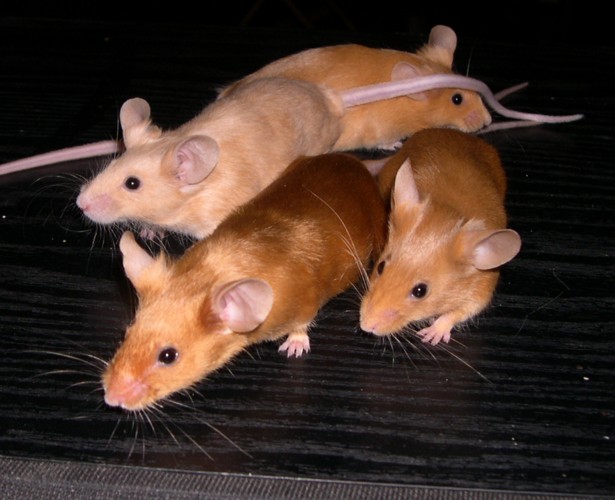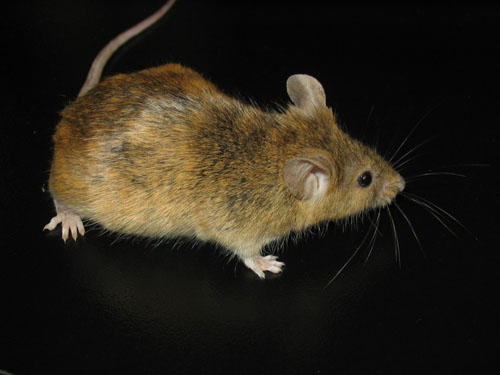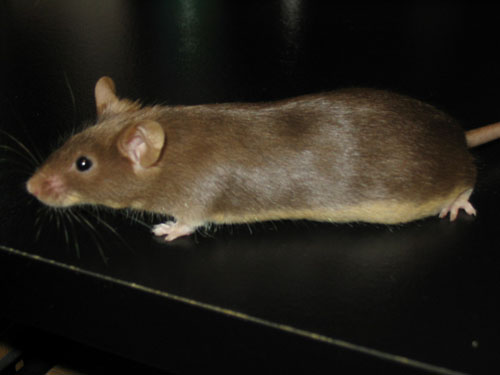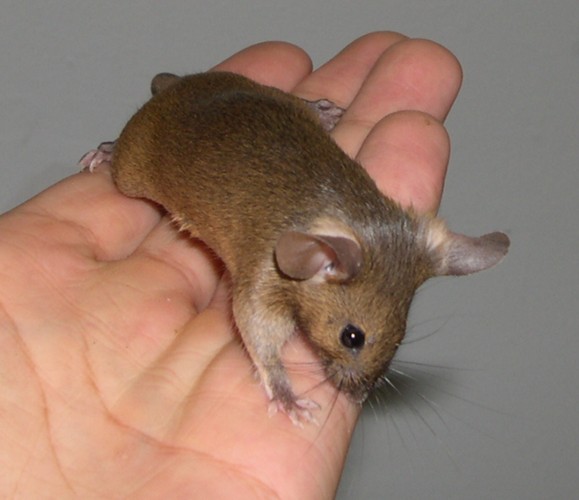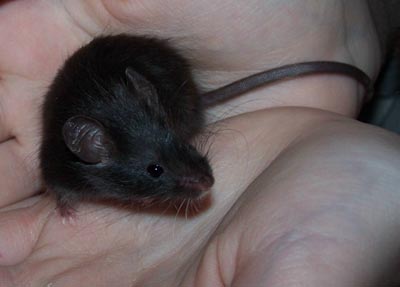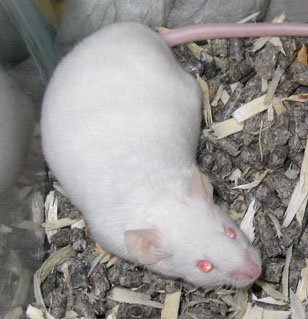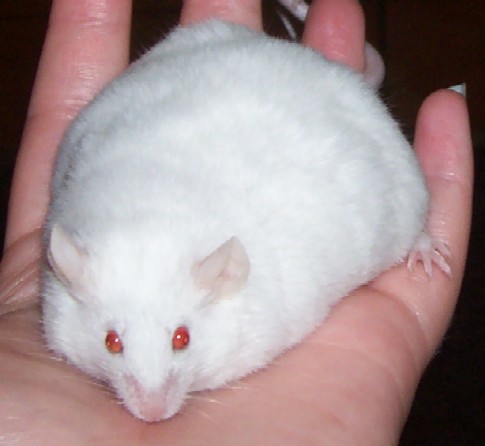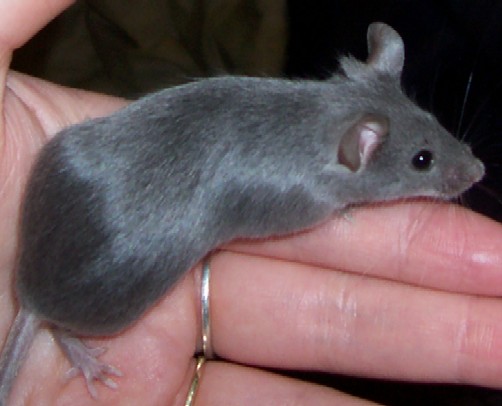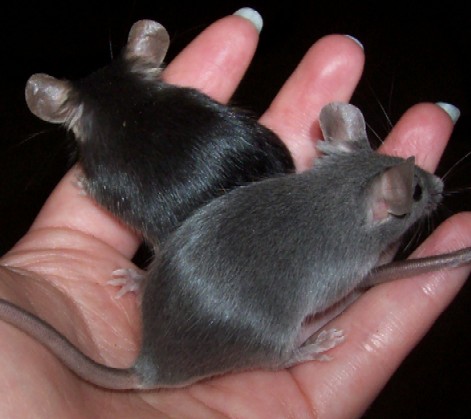|
|
|
|
A locus
This is the place where the base colour of the mouse is established
|
|
|
Ay
|
| Yellow is the most dominant colour; mice with this gene are prone to obesity. Yellow mice can vary in colour from light yellow to red, depending on the presence of modifiers; this gene is lethal when it is homozygous (Ay/Ay), so all yellow mice will be heterozygous (Ay/_). |
|
|
|
|
|
Avy
|
| Brindle is dominant to all but yellow (Ay). A typical brindle will be yellow with black or agouti stripes, resembling a tiger; however, the appearance of brindle mice can be altered by the presence of dilution on other loci. Brindle is also prone to obesity. |
|
|
|
|
|
at
|
| Tan is co-dominant to both Yellow (Ay) and Brindle (Avy); these mice will have no stripes on their undersides. |
|
|
|
|
|
A
|
|
Agouti (A) is the colour of wild mice. The hair consists of a black base with yellow banding on each hair, producing the visual impression of a multi-hued brown.
|
|
|
|
|
|
a
|
| Non-agouti mice (a/a) lack the yellow banding on the hairs, as in agouti mice (A/_), and therefore appear black. They may have white hairs on their sides and bellies. |
|
|
|
|
ae
|
| Extreme non-agouti mice (a/ae) lack any white ticking, and display black ears, feet and tail. These mice are known as “extreme black” or “super black”, and are very rare. |
|
|
|

|
|
|
|
|
B locus
This determines whether there is brown dilution
|
|
|
B
|
| Full colour intensity; no dilution effects present. |
|
|
|
|
b
|
| Brown dilutes black pigment to chocolate and can also have an effect on the eye color making them very dark ruby.Although yellow mice with a black or brown background look the same, brighter yellows are found with the chocolate background.A brindle mouse with brown dilution (Avy/_ b/b) will appear reddish with brown stripes.An agouti mouse with a chocolate background (A/_ b/b C/_ ) has the black bands in its fur brown, a color we call cinnamon.A non-agouti mouse with a chocolate back ground (a/a b/b C/_) is a brown colored mouse we call chocolate. |
|
|

|
|
|
|
|
C locus
This determines a variety of dilution effects which affect all colours
|
|
|
C
|
| Full colour intensity; no dilution effects present. |
|
|
|
|
cch
|
| Chinchilla dilution (cch)Yellow mice with chinchilla dilution (Ay/_ cch/cch) are a beautiful cream color. These mice can be selected to be bone, or cream depending on the modifier genes present.A chinchilla diluted agouti (A/_ B/_ cch/cch) is a gray mouse with ticking in the fur. It is known as a chinchilla mouse when also paired with the tan gene (A/at B/_ cch/cch) which chinchilla dilutes to white.Black mice with chinchilla dilution (a/a B/_ cch/cch) are off-black colored, somewhat grayer than normal black, but this is very hard to tell unless compared to a full Colored black (a/a B/_ C/_).Although literature states the chinchilla dilution has no effect on chocolate, chocolate chinchilla mice (a/a b/b cch/cch) are also off-chocolate but no where near coffee in color.In tan mice (_/at cch/cch) the tan underside is diluted to white, producing what is referred to as a “fox” mouse. |
|
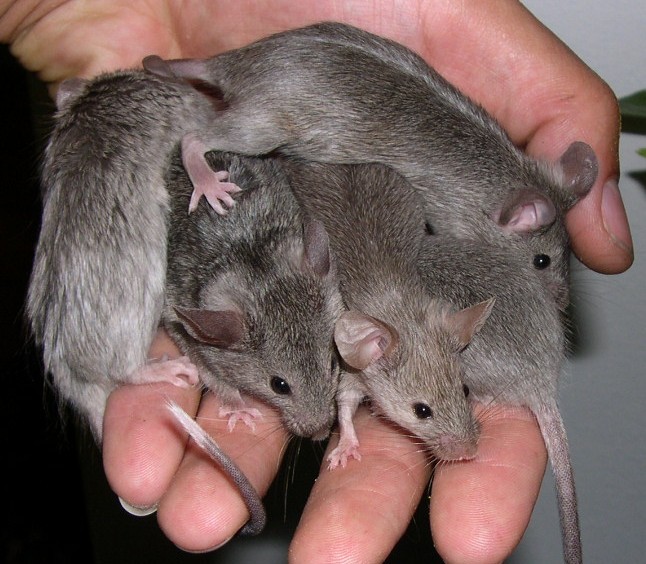
Chinchillated agouti |
|
|
|
ce
|
| Extreme Dilution (ce) dilutes yellow pigment to pure white, and black and brown pigments to beige. Eye color is unaffected.A yellow mouse that has extreme dilution (Ay/_ ce/ce) is a black eyed white.A brindle mouse with extreme dilution (Avy/_ B/_ ce/ce) will be white with pale grey stripes, also known as a White Tiger Brindle.An agouti mouse that has extreme dilution (A/_ B/_ ce/ce) is a very pale uneven beige color, or coffee.A black (a/a B/_ ce/ce) or brown (a/a b/b ce/ce) mouse that is homozygous for extreme dilution is diluted to beige as well. |
|
|
|
|
ch
|
| Siamese dilution (ch) dilutes brown and black fur to an off-white beige but causes the fur to be acromelanistic. This means the fur is temperature sensitive, with the cooler parts being darker than the warmer parts of the body. The eyes are also diluted which are pink eyed at birth and turn dark ruby as the mouse ages.Yellow Siamese mice (Ay/_ch/ch) can be difficult to identify as they won’t show points, but will be a ruby-eyed white.An agouti mouse with Siamese dilution (A/_ B/_ ch/ch) is a dingy-sooty mouse that has points, but does not have an even coat. The tips of the fur are usually dark-tipped.A black mouse with Siamese dilution (a/a B/_ ch/ch) is a Siamese mouse with a beige coat and dark points on the nose, tail, and feet.Chocolate Siamese mice (a/a b/b ch/ch) are beige mice with chocolate points; the points are lighter than those found on Siamese mice.Himalayan mice are Siamese mice which carry albino (ch/c) and have white bodies with points in any standard colour. |
|
|
|
|
c
|
| Albino is the ultimate dilution gene, as it covers up the expression of any color on the other alleles. Albino on any color is a pink eyed white mouse.Yellow albinos (Ay/_ c/c) and brindle albinos (Avy/_ c/c) still get obese; you will not be able to tell the genetics of an unknown albino except through breeding tests. |
|
|
|

|
|
|
|
|
D locus
This determines whether there is blue dilution
|
|
|
d
|
| Blue Dilution (d) has a strong effect on yellow and black pigments.A yellow mouse with blue dilution (Ay/_ C/_ d/d) are half way between cream and yellow, but have a light tipping on the fur and thus are often difficult to determine just what color they are.A brindle mouse with blue dilution (Avy/_ B/_ C/_ d/d) will appear buff with blue stripes.An agouti mouse with blue dilution (A/_ B/_ C/_ d/d) is an uneven slate gray with light bands which cause it to appear lighter than a non agouti blue mouse.A black mouse with blue dilution (a/a B/_ C/_ d/d) has the fur diluted to a slate gray-blue color known as blue.
Chocolate mice with blue dilution (a/a b/b C/_ d/d)are a warmer gray known as dove. |
|
|
|

|
|
|
|
|
|
|
E locus
This allows for yellow colouration without obesity
|
|
|
e
|
|
Extension (e) gene is also known as recessive yellow.
This gene is visually the same as Avy, but genetically
different.
Recessive yellows do not have obesity problems, and therefore do not incur health problems and sterility as do dominant yellows.
|
|
|
|
|
|
|
|
|
|
|
P locus
This determines if the eyes are diluted from black to pink; also affects hair colour
|
|
|
P
|
|
Black eyes; no dilution effects present.
|
|
|
|
|
|
p
|
|
Pink eye dilution (p) has a very strong effect on black/brown pigment, but none whatsoever on yellow pigments. All mice with this gene have pink eyes, if the eyes are not pink, another gene is responsible for the coloration.
A yellow mouse with pink eye dilution (Ay/_ C/_ p/p) only has the eyes altered as yellow fur is not affected at all. This is a fawn mouse, and a good way to make yellow clear and non-sooty as the pink eyed gene dilutes any black or brown found in the coat.
An agouti mouse with pink eyed dilution (A/_ B/_ C/_ p/p) is a beautiful color called Argente. These mice appear golden but they have a pale gray undercoats with bright gold tips.
A black mouse with pink eyed dilution (a/a B/_ C/_ p/p) has the black fur diluted a warm gray known as lilac.
A chocolate mouse with pink eyed dilution (a/a b/b C/_ p/p) are a pale tan color, and are called champagne.
|
|
|
|
|
|
|


